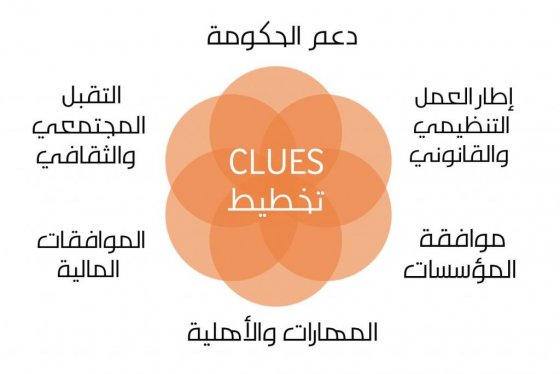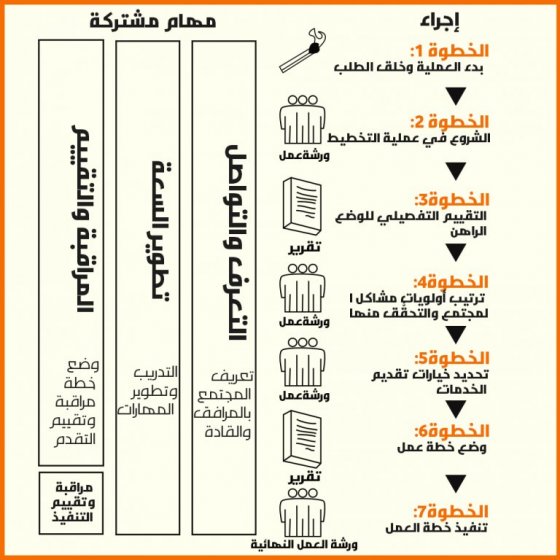الخطوة 3: التقييم التفصيلي للوضع الراهن
في الخطوة 3 يجمع المعنييون معلومات حول البيئة الطبيعية والاجتماعية-الاقتصادية للمنطقة المقرّر تطويرها، و تعتبر هذه الخطوة مهمة لأنها توفّر معلومات أساسية لجميع خطوات التخطيط المستقبلية، ومن ضمن نواتجها ىالخروج ببيانات مُنقّحة ودقيقة لـ تحديد المعنيين الحصول على المعطيات الأساسية وتقييم دقيق لـ البيئة المواتية والمستوى الحالي لتقديم الخدمات، ويأتي الناتج الأساسي للخطوة 3 في صورة تقرير مُفصّل لتقييم الوضع الحالي في المنطقة المقرّر تطويرها.
الخطوة 4: ترتيب أولويات مشاكل المجتمع والتحقق منها
في الخطوة 4، يتشاور المعنييون (Stakeholders) في النتائج والتطبيقات الناتجة عن تقرير التقييم، ويحددون المشكلات العامة والبيئية البارزة للصرف الصحي في المجتمع، ومن ثم يقومون بترتيبها بحسب الأهمية، أما النتائج الرئيسية للخطوة 4 فتتمثّل في المصادقة على تقرير التقييم وقائمة المشكلات المتفق عليها حسب الأولوية في المجتمع.
الخطوة 5: تحديد خيارات الخدمات
في الخطوة 5 يستخدم فريق التخطيط - بالتشاور مع الخبراء في مجال الصرف الصحي البيئي وأصحاب المنفعة الأساسيين - منهج الاختيار المستنير لتحديد خيار أو اثنين من خيارات نظم الصرف الصحي. البيئي الملائمة و القابلة للتطبيق في للمنطقة المقرّر تطويرها والتي يمكن دراستها بتفصيل أكثر، وفي هذه الخطوة يتوصل المجتمع والسلطات المحلية إلى اتفاق بناءً على فهم التطبيقات والمقترحات الإدارية والمالية للأنظمة المختارة.
الخطوة 6: وضع خطة عمل
في الخطوة 6 يضع المعنيون خطط العمل محلية للمنطقة، من أجل تطبيق وتنفيذ خيارات الصرف الصحي البيئي التي تم اختيارها في الخطوة 5 . يجب أن تكون خطط العمل قابلة للتنفيذ من قِبَل المجتمع متمثلًا في السلطات المحلية والقطاع الخاص (انظر أيضًا الشراكات بين القطاع العام والخاص).، أما الناتج الرئيسي للخطوة 6 فيتمثّل في وضع خطة عمل يتم تمويلها وتسير سعيًا لتحقيق أهداف محددة النتائج ويحكمها جدول زمني محدد ودقيق ، ويجب أن تحتوي كل خطة عمل على خطة لإدارة عمليات التشغيل والصيانة (O&M) لضمان التشغيل الصحيح لنظام الصرف الصحي الجديد.
الخطوة 7: تنفيذ خطة العمل
بما أن هدف الخطوة 7 هو تنفيذ خطة عمل CLUESالموضوعة في الخطوة 6، فإن هذه الخطوة الأخيرة لا تعدّ جزءً من عملية التخطيط بأية حال، يقوم المعنييون بتفعيل خطة العمل بتقسيمها إلى مراحل تتحول في النهاية إلى عقود لتنفيذ تطوير الخدمات. و تكون المرحلة الأخيرة للخطوة 7 هي تنفيذ خطة عمليات التشغيل والصيانة (O&M)
من الذي ينبغي أن يشارك في عملية التخطيط؟
ينبغي بدء عملية التخطيط رسميًا بعد اللقاءات المجتمعية في الخطوة رقم 1 في صورة ورشة عمل تضم مختلف المعنيين من أصحاب القرار. ينبغي أن يقوم شخص خبير بالمساعدة والتوجيه بإدارة ورشة العمل لضمان الاعتدال وتحقيق المعايير، على أن يحضر هذه الورشة أصحاب المنفعة على اختلاف خلفياتهم والذين تم تحديدهم خلال فعاليات بدء الحدث، كما يجب أن تضم الورشة قائد العملية، ومندوبين الصحة بالبلدية، و البلديات والمسؤولة عن المقاطعة، وممثلي المرافق، والمنظمات غير الحكومية (NGOs)، ومدرسي الجامعات والطلبة وممثلين عن مختلف قطاعات المجتمع المحلي - بما في ذلك لجنة تنسيق المشروع.
المهام المشتركة
توجد 3 مهام مشتركة ووثيقة الصلة تتم خلال عملية التخطيط الكلية :
1. يعد رفع الوعىوالتواصل عاملين أساسيين لـ خلق الطلب , ولرفع قدرات السكان على اتخاذ قرارات واعية بشأن الأنظمة والتقنيات الأكثر ملاءمةً لهم.
2. يهدف تطوير الطاقات والقدرات إلى تقوية مهارات إدارة العملية، والتخطيط الجماعي التشاركي، بالإضافة إلى الخبرات الهندسية، والإنشائية، وتلك المتعلقة بالتشغيل، والصيانة.
3. تتيح عملية مراقبة وتقييم سير المشروع (انظر أيضًا: المراقبة والتقييم التشاركي) الفرصة لتحديد الأخطاء أو مَوَاطن عدم التوازن وتصحيحها، بالإضافة إلى إمكانية تعديل شكل واتجاه المشروع قبل فوات الأوان.
العناصر الستة الأساسية للبيئة المواتية

العناصر الستة الأساسية للبيئة المواتية. المصدر: LUETHI et al. (2011)
يعد نهج CLUES بمثابة خطوة متقدمة لمنهج التخطيط لإنشاء نظام صرف صحي بيئي على مستوى المنزل (HCES: Household-Centred Environmental Sanitation) (EAWAG 2005) والذييقوم على مبادئ بيلاجيو (Bellagio) للمرافق الصحية المستدامة (EAWAG/SANDEC وWSSC 20). نبعت الفكرة الخاصة بمنهج HCES من الفريق العامل في مجال مرافق الصرف الصحي الصديقة للبيئة التابع للمجلس التعاوني لإمدادات المياه والصرف الصحي (WSSCC)، ثم تبعتها جهود مكثَّفة لاختبار منهج HCES بشكل تجريبي وتقييمه في الفترة بين 2006 و2010 في أفريقيا، وآسيا، وأمريكا اللاتينية، وذلك في سبع مواقع حضرية وشبه حضرية، وتم استخدام التجارب والخبرات والدروس المستفادة من هذه المشاريع التجريبية في تطوير مجموعة مُنَقَّحة ومبسطة من المبادئ التوجيهية للتخطيط (LUETHI وآخرون 2011). لذلك فإن تغيير الاسم من نهج الصرف الصحي البيئي المنزلي HCES إلى نهج القيادة المجتمعية للصرف الصحي في المدن CLUES يسلّط الضوء على أهمية المشاركة المجتمعية الأوسع نطاقًا (والتي تتعدى المستوى المنزلي) في عملية التخطيط واتخاذ القرار.
في خطة عمل CLUES يتم تحديد الحلول الأكثر استدامة من خلال التعبئة العامة لجميع المستفيدين وإشراكهم - وخاصةً المجموعة المجتمعية المستهدفة - مع الأخذ في الاعتبار الصعوبات الموجودة على أرض الواقع، والأولويات والموارد المتاحة على الأرض، و يتضمن التخطيط في CLUES تطوير خطة عمل لها جدول زمني وترتبط بالأداء العام والنتائج ويمكن تنفيذها بواسطة المجتمع، والسلطات المحلية، والقطاع الخاص و يجب أن توضح خطة العمل هذه استراتيجيات الإدارة لعمليات التشغيل والصيانة للحلول المتبعة.
يتضمن منهج CLUES ثلاث عناصر مميزة: 7 خطوات تخطيط، و3 مهام متداخلة ووثيقة الصلة تتم خلال عملية التخطيط الكلية، والبيئة المواتية و المطلوبة لإجراء عمليات تدخل مستدامة.

نظرة شاملة على منهج تخطيط CLUES. المصدر: LUETHIوآخرون. (2011)
تبدأ عملية التخطيط بالاستعداد والبدء مباشرةً بعمل الأنشطة الترويجية، وتهدف هذه الخطوة إلى توعية المجتمع بالصرف الصحي البيئي وinvalid link وخلق القوة الدافعة والمنصة الصلبة تمهيدًا للمشاركة المجتمعية، وبعد إجراء تخطيط المجتمع التشاركي ومناقشة الاهتمامات الرئيسية مع السكان في أول لقاء مجتمعي، تتم صياغة الاتفاق على خطة عمل ويتم تشكيل فريق عمل لتنفيذ المهام يتكوَّن من روَّاد للعمل المجتمعي يتم تحديدهم مسبقًا.
في الخطوة 2 يعقد جميع المعنيين اجتماعًا رسميًا لتطوير فهم مشترك لـ مشكلات الصرف الصحي البيئي في المنطقة المقرر تطويرها ويتم الاتفاق على طريقة التعامل مع هذه المشكلات، يجب أن تكون ورشة العمل الأوليّة شاملة وجيدة التنظيم، ويجب أن تجذب انتباه الناس وتلقى اهتمامًا شعبيًا، في الخطوة 2 يصدر المستفيدون بروتوكول اتفاقية – وهو عبارة عن اتفاقية معنيّة بحدود المشروع والاتفاق على الإطار العام لمنهجية التخطيط للمشروع و تنفيذ مراحله.
Subscribe here to the new Sanitation and Water Entrepreneurship Pact (SWEP) newsletter. SWEP is a network of organizations joining hands to help entrepreneurs design and develop lasting water and sanitation businesses.
يتم إعداد منهج CLUES للعمل على المستوى المجتمعي بحيث يتكامل مع مناهج تخطيط البنية التحتية للمدن، مثل: إطار عمل الصرف الصحي 21 أو invalid link، وينحصر التركيز الجغرافي على المناطق السكنية العشوائية وغير المخطَّطة التي تنشأ في المدن وما حولها (من مناطق حضرية وشبه حضرية) في أفريقيا وآسيا وأمريكا اللاتينية حيث توجد الكثير من التحديات التي تواجه تطوير الخدمات.
وكما ذكرنا أعلاه فإن البيئة المواتية وطريقة فهمها تعدّ العامل الأساسي المحدد لنجاح وفعالية عمليات التدخل الخاصة بالمشروع. تعتمد فعالية ونجاح عملية CLUES أيضاً بشكلٍ كبير على الظروف المحلية الملائمة، فعلى سبيل المثال: ينبغي أن يكون المجتمع متجانسًا نسبيًا- بلا انقسامات داخلية خارجة عن السيطرة، لذايجب تجنّب المجتمعات غير المستقرة والتي تفتقد الترابط والتماسك المجتمعي.
ومن ثم فإنه ينبغي تقييم إمكانية تطبيق CLUES عن طريق دراسة الوضع المحلي القائم وتحديد العناصر الواجب معالجتها من أجل إنجاح البرنامج و العمل على ضمان تحقيق هذه التغييرات.
Household-Centred Environmental Sanitation, Implementing the Bellagio Principles in Urban Environmental Sanitation – Provisional Guideline for Decision Makers
This guideline for decision-makers has been developed to provide first guidance on how to implement the Bellagio Principles by applying the HCES approach. Assistance is given to those willing to include and test this new approach in their urban environmental sanitation service programmes. Since practical experience with the HCES approach is lacking, this guideline is neither comprehensive nor final, but will have to be developed further on the basis of extensive field experience. Available in English, French and Spanish.
EAWAG (2005): Household-Centred Environmental Sanitation, Implementing the Bellagio Principles in Urban Environmental Sanitation – Provisional Guideline for Decision Makers. Geneva, Switzerland: Swiss Federal Institute of Aquatic Science and Technology URL [Accessed: 17.06.2019]Summary Report of Bellagio Expert Consultation on Environmental Sanitation in the 21st Century
This report summarises the Bellagio principles, which can be considered a basis for sustainable sanitation approaches.
EAWAG ; SANDEC ; WSSCC (2000): Summary Report of Bellagio Expert Consultation on Environmental Sanitation in the 21st Century. Duebendorf & Geneva: Swiss Federal Institute for Aquatic Science and Technology EAWAG & Water Supply and Sanitation Collaborative Council URL [Accessed: 18.06.2019]People’s Choice First, A 4-Country Comparative Validation of the HCES Planning Approach for Environmental Sanitation
From 2006 until the end of 2008, the HCES guidelines, and the concept of a participatory top-down/bottom-up planning approach, were tested in seven different urban and peri-urban sites across Africa, Asia and Latin America. Case studies from four of the seven sites are presented and analysed in this publication.
LUETHI, C. MOREL, A. KOHLER, P. TILLEY, E. (2009): People’s Choice First, A 4-Country Comparative Validation of the HCES Planning Approach for Environmental Sanitation. (= NCCR North-South Dialogue, no. 22 ). Bern: NCCR North-South URL [Accessed: 18.06.2019]Integrate at the Top, Involve at the Bottom – The Household-Centred Approach to Environmental Sanitation. Paper presented at the IRC Symposium: Sanitation for the Urban Poor Partnerships and Governance
This paper presents initial experience with implementation of the Household-Centred Environmental Sanitation (HCES) approach, jointly developed by the WSSCC and EAWAG-SANDEC. The presentation explores the theoretical foundations, the problems it seeks to address and practical experience with implementing the novel planning approach, presenting two case studies, one each from Tanzania and Laos.
LUETHI, C. MOREL, A. TILLEY, E. (2008): Integrate at the Top, Involve at the Bottom – The Household-Centred Approach to Environmental Sanitation. Paper presented at the IRC Symposium: Sanitation for the Urban Poor Partnerships and Governance. URL [Accessed: 18.06.2019]Community-Led Urban Environmental Sanitation Planning (CLUES)
CLUES presents a complete set of guidelines for sanitation planning in low-income urban areas. It is the most up-to-date planning framework for facilitating the delivery of environmental sanitation services for urban and peri-urban communities. CLUES features seven easy-to-follow steps, which are intended to be undertaken in sequential order. Step 5 of the planning approach relies on the Compendium, applying the systems approach to select the most appropriate technological option(s) for a given urban context. The document also provides guidance on how to foster an enabling environment for sanitation planning in urban settings. Published in 2011, 100 pages, with a memory key.
LUETHI, C. MOREL, A. TILLEY, E. ULRICH, L. (2011): Community-Led Urban Environmental Sanitation Planning (CLUES). Dubendorf: Swiss Federal Institute of Aquatic Science and Technology (Eawag) URL [Accessed: 18.06.2019]Enabling Environments for Civic Engagement in PRSP Countries. Social Development Notes
كتيب الادارة المتكاملة للموارد المائية فى احواض الانهار والبحيرات وطبقات المياة الجوفية العابرة للحدود
ﺩﻟﻴﻞ ﺧﻄﺔ ﺳﻼﻣﺔ ﺍﻟﻤﻴﺎﻩ ﺩﻟﻴﻞ ﻣﻔﺼﻞ ﻹﺩﺍﺭﺓ ﺍﻟﻤﺨﺎﻃﺮ ﻟﻤﻘﺪﻣﻲ ﻣﻴﺎﻩ ﺍﻟﺸﺮﺏ
يعد ﺩﻟﻴﻞ ﺧﻄﺔ ﺳﻼﻣﺔ ﺍﻟﻤﻴﺎﻩ ﺩﻟﻴﻞ ﻣﻔﺼﻞ ﻹﺩﺍﺭﺓ ﺍﻟﻤﺨﺎﻃﺮ ﻟﻤﻘﺪﻣﻲ ﻣﻴﺎﻩ ﺍﻟﺸﺮﺏ ويهدف إلى تقديم الإرشاد العملي، لتسهيل تطوير خطة سلامة المياه، مع التركيز على إمدادات المياه المنظمة التي تديرها منشأة مياه أو ما شابه.
منظمة الصحة العالمية (2009): ﺩﻟﻴﻞ ﺧﻄﺔ ﺳﻼﻣﺔ ﺍﻟﻤﻴﺎﻩ ﺩﻟﻴﻞ ﻣﻔﺼﻞ ﻹﺩﺍﺭﺓ ﺍﻟﻤﺨﺎﻃﺮ ﻟﻤﻘﺪﻣﻲ ﻣﻴﺎﻩ ﺍﻟﺸﺮﺏ . PDFLanguage: Arabic
Household-Centred Environmental Sanitation, Implementing the Bellagio Principles in Urban Environmental Sanitation – Provisional Guideline for Decision Makers
This guideline for decision-makers has been developed to provide first guidance on how to implement the Bellagio Principles by applying the HCES approach. Assistance is given to those willing to include and test this new approach in their urban environmental sanitation service programmes. Since practical experience with the HCES approach is lacking, this guideline is neither comprehensive nor final, but will have to be developed further on the basis of extensive field experience. Available in English, French and Spanish.
EAWAG (2005): Household-Centred Environmental Sanitation, Implementing the Bellagio Principles in Urban Environmental Sanitation – Provisional Guideline for Decision Makers. Geneva, Switzerland: Swiss Federal Institute of Aquatic Science and Technology URL [Accessed: 17.06.2019]Integrate at the Top, Involve at the Bottom – The Household-Centred Approach to Environmental Sanitation. Paper presented at the IRC Symposium: Sanitation for the Urban Poor Partnerships and Governance
This paper presents initial experience with implementation of the Household-Centred Environmental Sanitation (HCES) approach, jointly developed by the WSSCC and EAWAG-SANDEC. The presentation explores the theoretical foundations, the problems it seeks to address and practical experience with implementing the novel planning approach, presenting two case studies, one each from Tanzania and Laos.
LUETHI, C. MOREL, A. TILLEY, E. (2008): Integrate at the Top, Involve at the Bottom – The Household-Centred Approach to Environmental Sanitation. Paper presented at the IRC Symposium: Sanitation for the Urban Poor Partnerships and Governance. URL [Accessed: 18.06.2019]Community-Led Urban Environmental Sanitation Planning (CLUES)
CLUES presents a complete set of guidelines for sanitation planning in low-income urban areas. It is the most up-to-date planning framework for facilitating the delivery of environmental sanitation services for urban and peri-urban communities. CLUES features seven easy-to-follow steps, which are intended to be undertaken in sequential order. Step 5 of the planning approach relies on the Compendium, applying the systems approach to select the most appropriate technological option(s) for a given urban context. The document also provides guidance on how to foster an enabling environment for sanitation planning in urban settings. Published in 2011, 100 pages, with a memory key.
LUETHI, C. MOREL, A. TILLEY, E. ULRICH, L. (2011): Community-Led Urban Environmental Sanitation Planning (CLUES). Dubendorf: Swiss Federal Institute of Aquatic Science and Technology (Eawag) URL [Accessed: 18.06.2019]Community-Led Urban Environmental Sanitation Planning (CLUES). Executive Summary
This two-page document provides an overview of the CLUES approach with its three distinct elements: 7 planning steps, 3 cross-cutting tasks relevant throughout the entire planning process, and the enabling environment which is required for sustainable interventions.
LUETHI, C. MOREL, A. TILLEY, E. ULRICH, L. (2011): Community-Led Urban Environmental Sanitation Planning (CLUES). Executive Summary. Dubendorf: Swiss Federal Institute of Aquatic Science and Technology (Eawag). [Accessed: 12.11.2011] PDFCommunity-Driven Sanitation Improvement in Deprived Urban Neighbourhoods
There is an international consensus that urban sanitary conditions are in great need of improvement, but sharp disagreement over how this improvement should be pursued. Both market-driven and state-led efforts to improve sanitation in deprived communities tend to be severely compromised, as there is a lack of effective market demand (due to collective action problems) and severe barriers to the centralized provision of low-cost sanitation facilities. In principle, community-driven initiatives have a number of advantages. This report investigates these challenges and opportunities.
MCGRANAHAN, G. (2013): Community-Driven Sanitation Improvement in Deprived Urban Neighbourhoods. Research Report. London, Bangladesh: London School of Hygiene and Tropical Medicine (LSHTM), International Center for Diarrhoeal Disease Research (ICDDR), International Institute for Environment and Development (IIED), WaterAid, Sanitation and Hygiene Applied Research for Equity (SHARE) URL [Accessed: 17.06.2019]People’s Choice First, A 4-Country Comparative Validation of the HCES Planning Approach for Environmental Sanitation
From 2006 until the end of 2008, the HCES guidelines, and the concept of a participatory top-down/bottom-up planning approach, were tested in seven different urban and peri-urban sites across Africa, Asia and Latin America. Case studies from four of the seven sites are presented and analysed in this publication.
LUETHI, C. MOREL, A. KOHLER, P. TILLEY, E. (2009): People’s Choice First, A 4-Country Comparative Validation of the HCES Planning Approach for Environmental Sanitation. (= NCCR North-South Dialogue, no. 22 ). Bern: NCCR North-South URL [Accessed: 18.06.2019]Environmental Sanitation Improvement Plan for Nala Development
This report presents the results of the Household-Centered Environmental Sanitation approach (HCES), validated in Nala, Nepal. The experience and lessons learned from this pilot project were used to develop the revised and simplified set of planning guidelines for CLUES.
CIUD (2010): Environmental Sanitation Improvement Plan for Nala Development . Kathmandu: Centre for Integrated Urban Development (CIUD)CLUES planning: introduction to the approach and case study from Nepal. Conference presentation
This presentation summarises the CLUES planning process in Nala, a peri-urban settlement near Kathmandu, Nepal. In Nala, there has been a strong demand from community to improve sanitation conditions. The document provides conclusions about the strengths and weaknesses of the CLUES approach, based on the case study in Nala.
SHERPA, M. (2011): CLUES planning: introduction to the approach and case study from Nepal. Conference presentation. Mumbai: WSSCC Global Forum on Sanitation and HygienePlanning Tools
This Sustainable Sanitation Practice (SSP) issue contains the following contributions: 1. Better Design Planning Tools, 2. Tackling Complex Urban Sanitation Problems, 3. The SSWM Toolbox, 4. Comparing Economic Costs of Sanitation
MUELLEGGER, E. ; LANGEGRABER, G. ; LECHNER, M. (2011): Planning Tools. (= Sustainable Sanitation Practice , 7 ). Vienna: Ecosan Club URL [Accessed: 01.07.2013]Guidelines for Community-Led Urban Environmental Sanitation Planning (CLUES)
This website of SANDEC, the Department of Water and Sanitation in developing Countries at the Swiss Federal Institute of Aquatic Science and Technology (EAWAG) provides more information on the CLUES approach. On this site you find a more interactive version of the guidelines, tool updates, interesting links as well as news on CLUES projects from all over the world.


